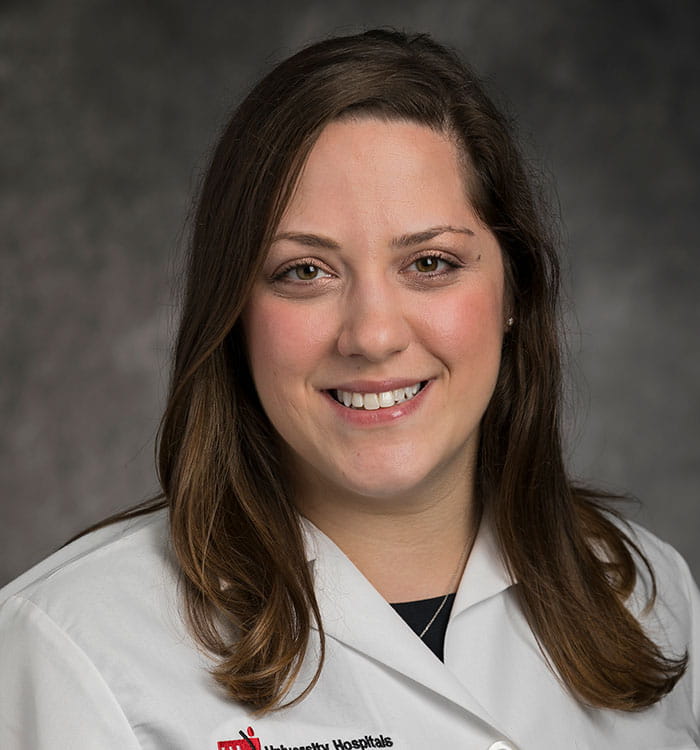New Osteosarcoma Trial at UH Rainbow Attracts National Attention
June 13, 2023
UH Clinical Update | June 2023
Between 10 and 20 percent of children, teens and young adults diagnosed with osteosarcoma have metastatic disease when first diagnosed, most commonly in the lungs. Even for those patients with non-metastatic disease, about 30 to 35 percent will have a pulmonary disease recurrence. The consequences are often grave.
 Kristen VanHeyst, DO.
Kristen VanHeyst, DO.“Although advances in therapy over the last four decades have improved overall survival in patients with osteosarcoma, there have been no significant improvements in the survival outcome of patients with metastatic disease,” says Kristen VanHeyst, DO, a pediatric oncologist at UH Rainbow Babies & Children’s Hospital. “Despite aggressive multimodal therapy, overall outcome for patients with pulmonary metastatic osteosarcoma remains dismal at 25-30 percent. For this reason, novel and directed therapy approaches are desperately needed.”
A research team, the Pediatric Hematology-Oncology Clinical Trials Unit (PHO CTU), at UH Rainbow is tackling this challenge head on, building on years of pre-clinical research with a new clinical trial. The trial, which is attracting patients to UH Rainbow from around the world, tests an off-label immunotherapy agent for children, adolescents and young adults with unresectable recurrent, refractory or progressive pulmonary metastatic osteosarcoma.
“The outcomes for metastatic osteosarcoma are pretty abysmal,” says pediatric oncologist Alex Huang, MD, PhD, Director of the Pediatric Immunotherapy Center at UH Rainbow and Theresia G. and Stuart F. Kline Family Foundation Chair in Pediatric Oncology. His lab has conducted the pivotal pre-clinical research that is the foundation for this new trial. “There is a great need to think out of the box, and we at UH Rainbow believe strongly that immunotherapy is the answer.”
Understanding the Science
Dr. VanHeyst is leading the new trial at UH Rainbow. She began collaborating with Dr. Huang and his lab team during her fellowship training at UH Rainbow and wrote the study protocol. It builds off the team’s work examining the interaction between a molecule called VCAM-1 (Vascular Cell Adhesion Molecule-1) and its partner macrophage site in the lungs, which appears to be important in disease spread.
“Studies suggest that VCAM-1 plays a role in the metastatic progression of various tumors,” Dr. VanHeyst says. “We believe that VCAM-1 over-expression by pulmonary metastatic osteosarcoma is critical in establishing a metastatic tumor niche in the lung tissue through its interaction with α4β1 integrin on lung macrophages. Interfering with this macrophage-mediated signaling can decrease established pulmonary metastatic osteosarcoma. Our data suggests that interfering with the signaling of VCAM-1 on pulmonary metastatic osteosarcoma and α4β1 on lung macrophages by down-regulating VCAM-1, depleting lung macrophages or functionally blocking VCAM-1/ α4β1 signaling reduces pulmonary metastatic osteosarcoma and improves survival.”
Study Details
Dr. VanHeyst and her colleagues have chosen the drug Natalizumab, approved by the U.S. Food and Drug Administration to treat multiple sclerosis and Crohn’s disease in adults, to test this hypothesis. Clinical data shows that the drug disrupts the interaction between α4β1 and VCAM-1.
“Although Natalizumab is only FDA-approved for treatment of T-cell-mediated autoimmune disorders in adults, the dosing has been used in pediatric patients in small studies without reported significant adverse side effects,” she says.
Patients in the trial will receive at least six cycles of Natalizumab therapy, administered on Day 1 of each 28 day cycle. The PHO CTU team is looking to establish dose limiting toxicity, as well as whether patients experience complete response, partial response or stable disease after 12 cycles.
The inclusion criteria for patients in the trial are quite narrow, Dr. VanHeyst says. Subjects, ages 5 to 30, must have measurable, documented pulmonary metastatic osteosarcoma that has progressed, relapsed or become refractory to conventional therapy. They must also have recovered from the major acute toxic side effects of all prior chemotherapy and immunotherapy prior to entering the study. Those who’ve received myelosuppressive chemotherapy must have adequate recovery of counts from previous treatment prior to entry. For those who’ve received monoclonal antibodies, at least three half-lives must have elapsed since prior therapy that included a monoclonal antibody. Subjects must also have a performance status score of 50 percent or above (60 percent for those age 16 or younger) and have normal organ and marrow function.
Dr. VanHeyst and the PHO CTU team will be submitting an amendment to the protocol that would allow a larger population of patients to be included on the study by further defining unresectable pulmonary disease. It may also allow patients that have localized disease elsewhere that could be treated with some other modality in addition to their pulmonary disease to enroll.
She encourages physicians who have questions about whether a patient might qualify to contact her directly.
“All people have to do really is just know they can reach out to us,” she says. “We'll answer any questions they have.”


